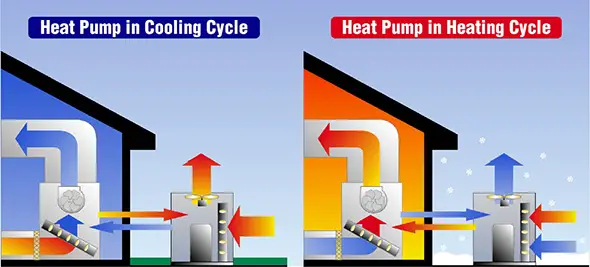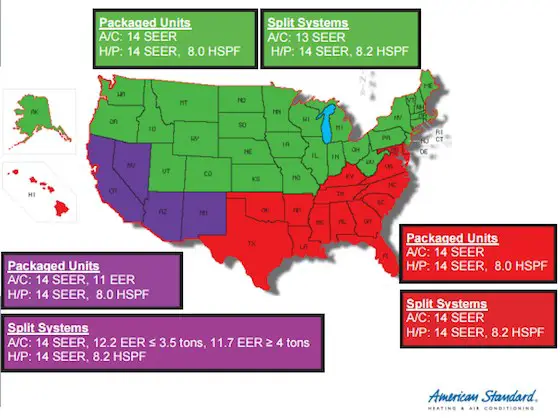Heat Pumps – How Well Do They Work?

How does a heat pump work? A heat pump is not much different than a car. You can go forward or reverse in a car. In the winter, the heat pump gets heat from the outside air and brings it into your home. In the summer, the heat pump works in reverse and takes heat from your home, and dumps it outside. In other words, a heat pump is both a heater and an air conditioner! It pumps the heat in different directions depending on the season!
"As the outdoor temperature continues to drop, the heat pump needs help from traditional electric resistance heat coils."
How Does a Heat Pump Work?
- Heat pumps extract heat from cold outdoor air
- They produce a cold heat from forced-air vents
- If outside temperature is below 37 F, heat pumps need to use electric resistance head coils inside the furnace to keep house warm
- Federal regulations require a refrigerant that can be more difficult to use
- CLICK HERE to subscribe to Tim's FREE & FUNNY Newsletter
Related Links
Return Air Ducts Key to Comfort
DEAR TIM: I am going to have a heat pump installed in my home. Can these systems really heat a house in cold weather? How does a heat pump work?
I'm confused about the energy efficiency ratings. Are some heat pumps more efficient than others?
Will I save money in the long run by buying the most efficient unit? Is it true that the refrigerant Freon-22 has been outlawed? Dennis S., Oregon City, OR
CLICK HERE to get FREE & FAST BIDS from heat pump technicians in your city or town.
DEAR DENNIS: Believe it or not there is heat in cool and cold air. Heat pumps can extract this warmth and inject it into your home. They achieve this by doing the same thing air conditioners do only backwards!
In hot weather air conditioners, using the magic of special refrigerant chemicals, take heat from the inside of your house and dispose of it outdoors. It only makes sense that the modified machines can do the exact opposite and pull heat from outdoor air and pump it into your home.
Do Heat Pumps Work Best at 50F?
Heat pumps work very efficiently when the outdoor temperature is in the 50 F range. As the outdoor temperature drops, the heat loss of a home is greater and the heat pump needs to operate for longer periods of time to maintain a constant indoor temperature.
Around 37 F many heat pumps reach what is called the balance point. At or near this temperature the heat pump needs to run constantly to produce enough heat to maintain a comfortable indoor temperature.
What Happens When The Temperature Drops?
As the outdoor temperature continues to drop, the heat pump needs help from traditional electric resistance heat coils. These coils resemble the glowing wires inside your toaster and consume vast amounts of electricity as they burn to keep you warm.
Your thermostat will most probably have a light that comes on when this happens. It is usually labeled as emergency or auxiliary heat.
If this light is on whenever your heat pump is working when the outdoor temperature is above 40 F, you should have a professional service your system.
CLICK HERE to get FREE & FAST BIDS from heat pump technicians in your city or town.
Do Heat Pumps Create Cold Heat?
Heat pumps have a reputation for producing what's called a cold heat. The air flowing from the air vents is around 90 F, and sometimes as low as 85 F.
This may seem warm or hot, but it's not when it's cold outdoors.
The temperature of the air coming out of floor registers that connect to a furnace burning natural gas, propane, or oil might be in excess of 110F if you're close to the furnace.
Are All Heat Pumps the Same Efficiency?
No, manufacturers can make heat pumps operate at different levels of efficiency. The more heat a system can produce or remove from a given amount of electricity, the more efficient it is.
A common measurement of this performance is the Seasonal Energy Efficiency Ratio (SEER).
What are the Newer Heat Pump SEER Regulations?
SEER numbers can vary widely if you compare old heat pumps to new ones. Heat pumps made and installed in the 1980's often had peak SEER numbers of 6.
Before the year 2015, the minimum SEER you can buy today was 13. Federal regulations are always changing and after January 1, 2015, the USA was divided into three regions:
- North (green area in the map below)
- South (red area in the map below)
- Southwest (purple area in the map below)

This map shows the three regions in the USA. Map is made possible by the Fair-Use portion of the US Copyright regulations and is courtesy of American Standard Heating and Cooling. CLICK the IMAGE to see the entire document.
CLICK HERE for a .pdf file created by the Air Conditioning, Heating, and Refrigeration Institute that explains the requirements. Remember, the requirements can change all the time.
The highest SEER heat pumps made at present are a tad over SEER 16. Any heat pump that has a SEER rating above 14 is very high efficiency.
Can SEER Numbers Be Misleading?
The SEER numbers are a little misleading. They actually are a measurement of the efficiency of the heat pump when it is in the cooling or air conditioning mode.
If you live in a warm or hot climate, it might make great sense to purchase a heat pump with a high SEER value. People who live in cool or cold climates may not get a payback for the extra money they spend for a high-value SEER heat pump.
What's more, those who have high electricity costs will save more than those who have access to inexpensive electricity. It can be confusing, to say the least.
For example, if your house needs a 3-ton heat pump, your average electric rate is $.0867 per kilowatt-hour, and you live in New England, you might only save $36 per year in cooling costs when you upgrade from a SEER 10 to a SEER 13 heat pump. Your overall savings when you heat and cool for an entire year might only be $189. A person who lives in south Florida who has the exact same system and utility rates could possibly save $173 per year in cooling costs and an overall annual savings of $215 by upgrading from a SEER 10 to 13. Professional heating and cooling contractors can help you estimate savings for your area.
Why is Freon-22 No Longer Available?
The Environmental Protection Agency, in accordance with the Montreal Protocol, is obligated to phase out over a period of years hydrochloroflourocarbon (HCFC) refrigerants used in heat pump and air conditioning systems.
Most residential systems years ago used a refrigerant called Freon-22 that happens to be in this group. Back in January 2004, contractors had to scale back the use of Freon-22. In 2020, Freon-22 will not be permitted to be imported nor manufactured in the USA.
Do New Refrigerants Operate at Higher Pressures?
The issue with the new refrigerant for you is that it requires much higher operating pressures within the heat pumps. This means the tiniest leak can turn into major problems.
The new regulations also created huge issues for contractors and technicians because they needed new meters, test equipment, etc. to work with the newly mandated refrigerants. But at the same time, they had to keep all old equipment to work on units with Freon-22.
Who Pays the Cost For The New Regulations?
This is but one example of how government regulations put a hidden tax on you. The contractors raise their prices to cover the huge investment they have to make in all the new equipment.
I say this so you understand that there are often secondary unintended consequences to what appear to be wonderful regulations. In the end, you and I pay for all of this. It's always passed through to the consumer.
If you still own one of the last Freon-22 heat pumps, you may have to pay a king's ransom to get your heat pumps filled with refrigerant if a leak develops.
If you’re interested in learning more about heat pump replacement cost I have an article here.
If you want the best heat, and this is my opinion, you want to have radiant floor heat. Once you've been in a home that has radiant floor heat, you'll never want a heat pump.
In the March 7, 2021 AsktheBuilder Newsletter, Wayne emailed asking about replacing or installation a new heating system. This popular column provided the information he needed.
CLICK HERE to get FREE & FAST BIDS from heat pump technicians in your city or town.
Column 294


25 Responses to Heat Pumps – How Well Do They Work?